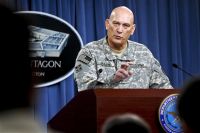WASHINGTON, July 21, 2010 — The military is on track to meet its drawdown goals in Iraq, and there will be plenty of troops left until the end of 2011 to help Iraq become fully independent, the commanding general of U.S. Forces in Iraq said today.
“I feel very comfortable that we will be at 50,000, probably by the last week of August,” Army Gen. Raymond T. Odierno said during a Defense Writers Group breakfast here followed by a Pentagon press briefing. Troop strength probably will stay around 50,000 through next summer, even though all U.S. forces are to be out of Iraq by Dec. 31, 2011, he said.
With 70,000 troops still in Iraq – down from 145,000 in January 2009 — the military is on schedule to meet President Barack Obama’s September drawdown goals, Odierno said. And, the general said, his command also is ahead of schedule in drawing down its equipment. Forty thousand wheeled vehicles have left the country – half bound for Afghanistan – and 1.2 million other pieces of equipment have been moved out, accounting for 95 percent of the equipment drawdown goal, he said.
At the height of the troop surge in 2007, the military had 608 facilities in Iraq, and now has 112, Odierno said. The command is on track to meet its goal of having 94 facilities in Iraq by September, he said.
“This is a significant interagency, interservice endeavor,” Odierno said, adding that it is the largest U.S. military redeployment since the end of the Vietnam War. “It speaks to the capacity and capability of our leaders” in Iraq that the drawdown is on track, he said.
The remainder of U.S. military assets planned for Iraq after September, Odierno said, will be enough to continue the mission of advising, assisting and training, and also support any lingering security challenges even if there is an uptick in violence. The mission now is transforming to support the State Department’s increasing presence in Iraq, he said, noting he made the trip from Baghdad to Washington to discuss the plan further.
The main challenges left for Iraq’s independence are political unity and financial solvency, the general said. Representatives of Iraq’s four major political groups finished very close in last March’s national elections, making negotiations over leadership difficult, he said.
The new government needs to reflect the wishes of voters and be inclusive of all of Iraq’s ethnic groups, Odierno said. He added that the Kurdish region of northern Iraq remains the most tenuous and the northern city of Kirkuk probably will be the last place U.S. troops depart.
“We clearly want a unity government,” the general said, “and I think there is no choice in that. To be successful, Iraq must have a unity government.”
Iraq is challenged by outside intervention in its political progress, especially from Iran, Odierno said. He added that Iran continues to train insurgent groups inside Iraq.
Iraq also has to improve its economy, Odierno said. About 95 percent of its revenue comes from oil, he said, but it will take Iraq another three to five years to produce enough oil to enable the country to become financially solvent.
Meanwhile, Iraqi officials are frustrated because there hasn’t been more outside investment in the country, Odierno said. However, more foreign investment in Iraq will occur, he said, as Iraq’s legal systems solidify.
Odierno said it is important for the United States to continue to support Iraq even after all U.S. troops leave there.
“It’s in our best interest that we continue to support them,” the general said. “We could have a great outcome” of stability in the Middle East, and a partnership with a key player.
“We have to be careful we don’t run away from them,” he added.
Source:
U.S. Department of Defense
Office of the Assistant Secretary of Defense (Public Affairs)

 von
von 
